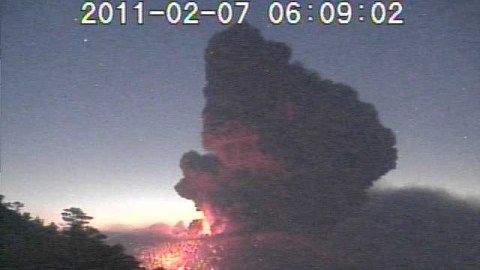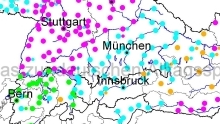Monday Musings: Noisy times in Japan and making tenuous connections between volcanoes and climate

Pieces of volcano news on this snowy Ohio Monday morning (and now that the Superbowl is done, only one week until the real sports begin again):
Japan: Eruptions reader and volcano documentarian extraordinaire mentions that Sakurajima had a rare, large explosion this morning, producing a 2 km / ~6,600 foot plume and, for the first time since 2009, from the Minami-dake crater at Sakurajima (many of the recent eruptions have come from the Showa crater). You can see some video of the explosion from the webcam feeds for Sakurajima here. If you’re curious about everything that is happening in Japan volcanically, check out the Japanese Meteorological Agency update (although you’ll need Google Translate if you don’t read Japanese). Over at Kirishima, the dome within the crater has grown to 600 meters in diameter (Japanese PDF; see below), and judging from some of the webcam captures by Eruptions readers (top left), the danger of potential tephra falling within 4 km of the crater while the ash fall from these explosions will likely be a problem near Kirishima for some time. UPDATE: Science has some great new images of the dome in the crater as well ~ very pancake-like dome. You can get yet another nice view of the Kirishima ash plume as snapped by the MODIS imager of Terra (all thanks to the NASA Earth Observatory). Remember, there are plenty of webcams for both volcanoes.

The dome at the Shinmoe-dake crater at Kirishima seen on February 7, 2011.
Climate and volcanoes: There is strong evidence of the direct effect that volcanism can have on climate. So, it should be no surprise that there are a couple of “interesting” articles I noticed this morning that are trying to connect the cold winter and bad storms with volcanic activity. The first links ash from the six active volcanoes in Kamchatka with causing the Arctic to become colder and the Arctic winds pushing southward. This southerly push of colder air means that agricultural belts are seeing colder weather and poorer crop yields, meaning (potentially) higher food prices later this year. The other article tries to link Eyjafjallajökull with the cold winter across the northern hemisphere ~ however, the attempt to link Iceland with this cold weather is flimsy at best.Without a more quantitative look at the amounts of ash and volcanic aerosols released by these volcanoe, both of these article offer little more than circumstantial evidence for the connection, so both of these article present is speculation at best.
Top left: A February 7, 2011 explosion at Kirishima captured via webcam by an Eruptions reader.





